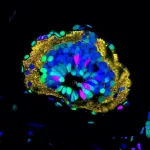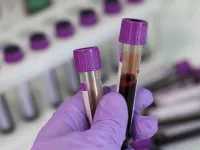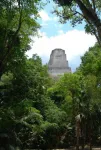Open learning spaces do not increase children's physical activity
However, more breaks from sedentary time were observed in open learning spaces compared to conventional classrooms
2021-06-22
(Press-News.org) According to a recent study, open learning spaces are not directly associated with the physical activity of students in grades 3 and 5, even though more breaks from sedentary time were observed in open learning spaces compared to conventional classrooms.
The findings are based on the CHIPASE study, carried out at the Faculty of Sport and Health Science of the University of Jyväskylä. The results were published in Frontiers of Sports and Active Life.
After the reform of the national core curriculum for basic education in Finland, issued in 2016, most of the new or renovated comprehensive schools in Finland began to incorporate open and flexible classroom designs and principles. Combined with student-centred pedagogies, these open learning spaces may increase children's physical activity during lessons. Classroom-based physical activity may also have a positive impact on academic-related outcomes.
"Surprisingly, students were physically less active in open learning spaces than in conventional classrooms," Says Doctoral Researcher Jani Hartikainen from Faculty of Sport and Health Sciences at the University of Jyväskylä. "In turn, open learning spaces seem to enable more breaks from sedentary time, which may decrease the potential adverse effects of prolonged sitting on the health of children."
The main result of the study was that, on their own, open learning spaces do not increase children's' physical activity during lessons. Future studies should seek to investigate and develop teacher practices to capitalise on the potential of open learning spaces to promote classroom-based physical activity.
"In this study, we did not observe teachers' instructions about students' movement, but prior studies have reported difficulties in how teachers adapt to open learning spaces," Hartikainen says. "Especially large student groups may cause teachers to need to restrict students' movement during lessons."
INFORMATION:
This study was published as part of the CHIPASE study, which is funded by the Ministry of Education and Culture of Finland. The study was based on cross-sectional data collected in 2015 and 2016 before and after renovations which replaced conventional classrooms with open learning spaces.
[Attachments] See images for this press release:

ELSE PRESS RELEASES FROM THIS DATE:
2021-06-22
The way in which a compound inspired by nature produces hydrogen has now been described in detail for the first time by an international research team from the University of Jena, Germany and the University of Milan-Bicocca, Italy. These findings are the foundation for the energy-efficient production of hydrogen as a sustainable energy source.
Nature as a model
There are naturally occurring microorganisms that produce hydrogen, using special enzymes called hydrogenases. "What is special about hydrogenases is that they generate hydrogen catalytically. Unlike electrolysis, which ...
2021-06-22
The relationship between personality, genes and chronotype (sleep patterns) has been studied by researchers at the University of Warwick and the University of Tartu, Estonia
People high in Conscientiousness and low in Openness are rather morning people; lower-level personality traits such as self-discipline, excitement-seeking, and straightforwardness have also been linked to chronotype
It is partly due to genetic factors, but there is scope to change your sleep patterns if you wanted to become a morning person but are currently an evening person for example
The link between the different hierarchies of personality, sleep patterns and even genetics has been discovered by ...
2021-06-22
Coastal wetlands like seagrass meadows, mangroves, and salt marshes play vital roles along the shoreline, from providing a buffer against storm surges, to providing critical habitat for animals, to capturing atmospheric carbon.
We are still just beginning to comprehend the intricate workings of these highly productive ecosystems and their role in mitigating the climate crisis, but UConn researchers are one step closer to understanding how salt marsh vegetation, their bacterial communities, and vegetation can help predict a marsh's potential to be a blue carbon reservoir. The research was recently published in the journal Estuaries and Coasts.
"Coastal marshes are increasingly recognized as important ecosystems because they sequester and store a lot of carbon. There is ...
2021-06-22
Most of us have genetic variations that increase the risk of medicinal products not being effective. In order to provide a more effective treatment with fewer side effects, we need to analyse more of these genetic variations. This will provide us with more precise knowledge about how the individual patient reacts to medicinal products. A new research result from Aarhus University shows that.
Personalised medicine has been a hot topic in recent years, using information about the genes to adapt the treatment to the individual patient. Personalised medicine potentially provides better treatment and fewer side effects for the patient. At least in ...
2021-06-22
WASHINGTON, June 22, 2021 -- About 2.2 billion people globally lack reliable access to clean drinking water, according to the United Nations, and the growing impacts of climate change are likely to worsen this reality.
Solar steam generation (SSG) has emerged as a promising renewable energy technology for water harvesting, desalination, and purification that could benefit people who need it most in remote communities, disaster-relief areas, and developing nations. In Applied Physics Letters, by AIP Publishing, Virginia Tech researchers developed a synthetic tree to enhance SSG.
SSG turns solar energy into heat. Water from a storage ...
2021-06-22
A team of scientists from the Leibniz Institute for Food Systems Biology at the Technical University of Munich has now discovered that the odorant receptor OR5K1 is specialized to recognize pyrazines in both humans and domesticated animals. These are volatile substances that contribute to the typical odor of many vegetables or are formed when food is heated. In addition, pyrazines also play a role as signaling substances in intra- or interspecific communication. The new research results contribute to a better understanding of the molecular mechanisms underlying the odor perception ...
2021-06-22
A single measurement result is not a proof - this has been shown again and again in science. We can only really rely on a research result when it has been measured several times, preferably by different research teams, in slightly different ways. In this way, errors can usually be detected sooner or later.
However, a new study by Prof. Andrej Pustogow from the Institute of Solid State Physics at TU Wien together with other international research teams shows that this can sometimes take quite a long time. The investigation of strontium ruthenate, a material that plays an important role in unconventional superconductivity, has now disproved an experiment that gained fame in the 1990s: it was believed that a novel form of superconductivity ...
2021-06-22
The spinal cord is an important component of our central nervous system: it connects the brain with the rest of the body and plays a crucial part in coordinating our sensations with our actions. Falls, violence, disease - various forms of trauma can cause irreversible damage to the spinal cord, leading to paralysis, sometimes even death.
Although many vertebrates, including humans, are unable to recover from a spinal cord injury, some animals stand out. For instance, the axolotl (Ambystoma mexicanum), a salamander from Mexico, has the remarkable ability to regenerate its spinal cord after an injury. When an axolotl's tail is amputated, neural stem cells residing in the spinal cord are recruited to the injury ...
2021-06-22
Researchers have identified a combination of biological markers in patients with dengue that could predict whether they go on to develop moderate to severe disease, according to a study published today in eLife.
Biomarkers are used to identify the state or risk of a disease in patients. Examples of biomarkers can include naturally occurring molecules or genes in the vascular, inflammatory or other biological pathways. The new findings could aid the development of biomarker panels for clinical use and help improve triage and risk prediction in patients with dengue.
Dengue is the most common mosquito-borne viral disease to affect humans globally. In 2019, the World Health Organization identified dengue as one of the top 10 threats to global health, with transmission occurring ...
2021-06-22
The ancient Maya city of Tikal was a bustling metropolis and home to tens of thousands of people.
The city comprised roads, paved plazas, towering pyramids, temples and palaces and thousands of homes for its residents, all supported by agriculture.
Now researchers at the University of Cincinnati say Tikal's reservoirs -- critical sources of city drinking water -- were lined with trees and wild vegetation that would have provided scenic natural beauty in the heart of the busy city.
UC researchers developed a novel system to analyze ancient plant DNA in the sediment of Tikal's temple and palace reservoirs to identify more than 30 species ...
LAST 30 PRESS RELEASES:
[Press-News.org] Open learning spaces do not increase children's physical activity
However, more breaks from sedentary time were observed in open learning spaces compared to conventional classrooms







